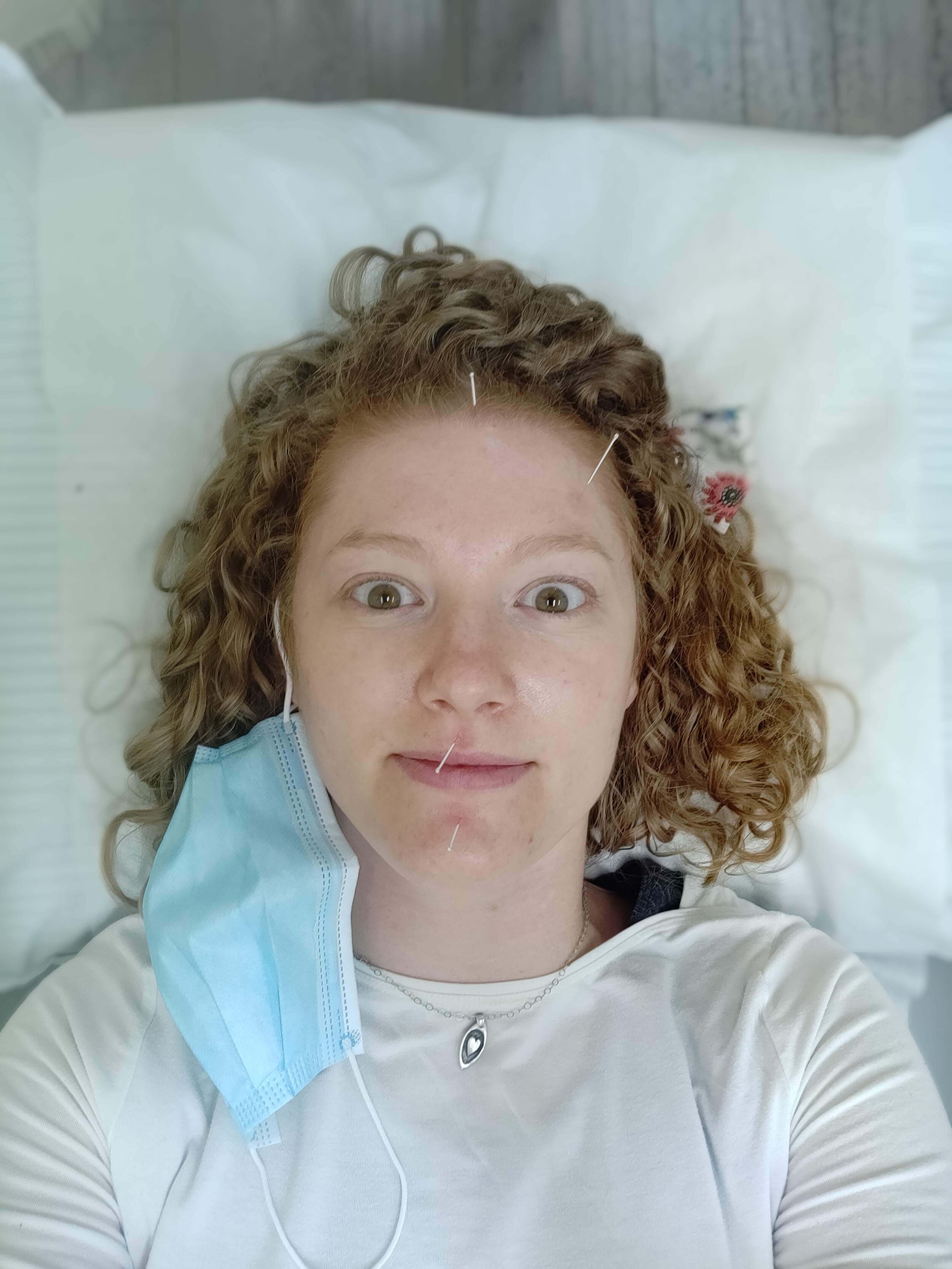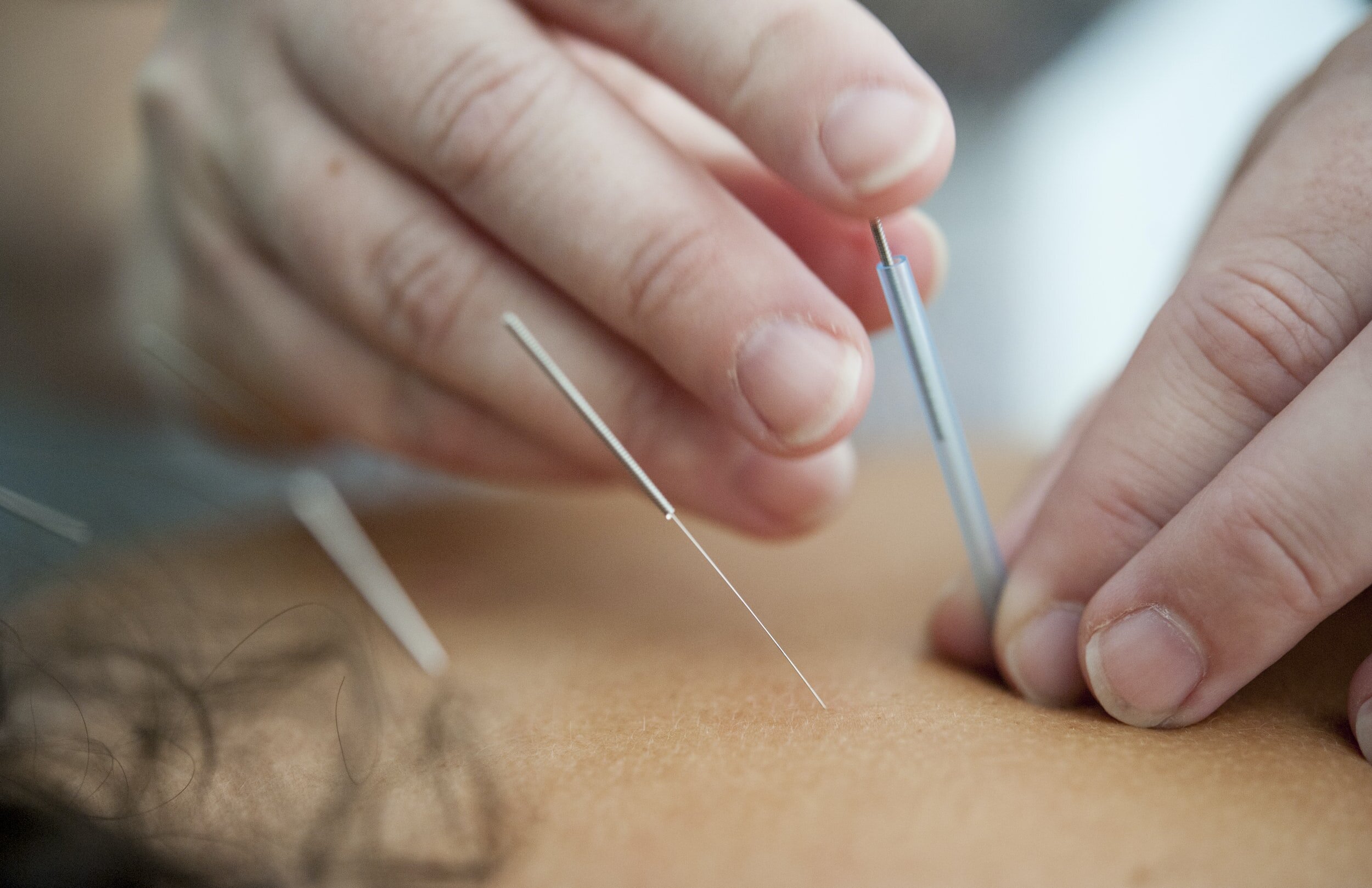Acupuncture Introduction: Right to the “Point”
Dr. B with acupuncture needles in her face. These facial acupuncture points may be used in the treatment of headaches. This selfie was taken during Dr. B’s acupuncture training course.
What is acupuncture?
Acupuncture is the placement of very small, fine needles at specific points in the body. In Traditional Chinese Medicine, acupuncture was used to move body energy, or Qi. In musculoskeletal medicine we use acupuncture to relieve pain and release tight muscles.
A visual demonstration of the size of an acupuncture needle (they’re really small!!).
Left to right: pen, acupuncture tube, acupuncture needle, business card.
Does acupuncture hurt?
Nope! Sometimes you’ll feel a slight pricking sensation as the needle enters the skin, and you may feel a “dull” or “full” sensation (known as “de Qi” in Traditional Chinese Medicine) while the needle is in place, but it shouldn’t be painful. If you are experiencing extreme pain in a certain location, there are treatment options wherein needles are placed at different sites from those that are very sore, and this can be discussed with your chiropractor or care provider. There are a few acupuncture points that tend to be more tender than others, but if you’re uncomfortable at any time your therapist can remove the needles for you.
Is acupuncture safe?
Yes acupuncture is absolutely safe!
If you’re interested in numbers - in a Japanese study of over 65,000 acupuncture treatments, there were 94 (0.14%) reported adverse events (Yamashita et al. 1999), and in a British study of over 31,000 consultations, significant adverse events were reported at a rate of 14/10,000 and minor events were reported at a rate of 671/10,000 (White et al. 2001).
Single-use acupuncture needles in their sterile packaging.
If the numbers don’t mean much for you - as with anything there are some risks to treatment, and those risks have been well-studied so that we can mitigate them and explain them to you with relation to your complaint, your health or medical conditions, and medications you might be taking, before treatment. Further, we apply many safety precautions in clinic, some of which are listed below.
Safety Precautions:
A complete history and physical examination to determine if acupuncture is right for you
Informed consent - we discuss risks and benefits to treatment before we start
We only use sterile, single-use needles
Sanitizing the skin before needle insertion
Proper disposal of needles in a sharps container
What can acupuncture treat?
There are many musculoskeletal conditions that can be managed in clinic with acupuncture (references linked - click on each condition), including:
ID: a person is laying face down receiving acupuncture therapy to the lower neck, upper back, and shoulder region. There are three needles already placed, and a fourth needle in a tube is being placed as the photo is taken.
elbow pain due to tendinopathies (Golfer’s Elbow, Tennis Elbow)
even arthritis!
If you have questions about non-musculoskeletal conditions and acupuncture, there are a variety of other professionals you can talk to including medical doctors (especially those trained in acupuncture) and naturopaths.
How does acupuncture work?
Traditional Chinese Medicine (TCM) and Western scientific research have two differing theories as to how acupuncture works. In TCM, applying acupuncture removes blockages and improves the flow of Qi, or body energy, allowing the body to return to its state of health. In Western medicine, we understand acupuncture to block pain stimulus, stimulate the body to produce endogenous endorphins (opioids produced by the body) and other body chemicals, and target tight muscles and trigger points.
How are chiropractors trained in acupuncture?
Here are some of the course materials Dr. B acquired during her training!
Chiropractors are required to obtain 200 hours of additional training to perform acupuncture. This training must include information about:
Traditional Chinese acupuncture: location of the meridians, 409 acupuncture points including their location, depth of insertion, and contraindications to using those points
Western medicine acupuncture: evidence, selection of patients for whom acupuncture will be beneficial, creation of effective treatment plans
Safety guidelines
Treatment techniques
With 200 hours of training (and many more hours of application in clinical practice) you can be assured your chiropractor can provide you safe and effective care.
Interested in seeing if acupuncture therapy might be right for you? Call now at 519-389-7078, or book a free consultation.
Further Reading
Check out some articles and publications hosted on the McMaster Medical Acupuncture website! https://acupuncture.mcmaster.ca/articles/
References
Deng, Liangyue, Yijun Gan, Shuhui He, Xiaoping Ji, Yang Li, Rufen Wang, Wenjing Wang, et al. 2003. Chinese Acupuncture and Moxibustion. Revised, Fourth Printing. Beijing: Foreign Languages Press.
Lin, Juang-Geng, and Wei-Liang Chen. 2008. "Acupuncture Analgesia: A Review of Mechanisms of Actions." American Journal of Chinese Medicine 36 (4): 635-645. Available from: https://www.worldscientific.com/doi/abs/10.1142/S0192415X08006107.
National Institute for Health. 1997. "Acupuncture." NIH Consensus Statement Online 15 (5): 1-34. Available from: https://consensus.nih.gov/1997/1997Acupuncture107html.htm.
Quality Assurance Committee. 2019. "Standards of Practice S-017 Acupuncture." College of Chiropractors of Ontario. February 27. Accessed December 12, 2020. https://cco.on.ca/wp-content/uploads/2019/05/S-017.pdf.
Trinh, Kien. 2018. Medical Acupuncture for Sports Medicine. Scarborough, Ontario: Datahome Publishing Co. Ltd.
White, Adrian, Simon Hayhoe, Anna Hart, and Edzard Ernst. 2001. "Adverse events following acupuncture: prospective study of 32000 consultations with doctors and physiotherapists." British Medical Journal 323: 485-486. Available from: https://www.ncbi.nlm.nih.gov/pmc/articles/PMC48133/.
Yamashita, Hitoshi, Tsukayama Hiroshi, Yasuo Tanno, and Kazushi Nishijo. 1999. "Adverse Events in Acupuncture and Moxibustion Treatment: A Six-Year Survey at a National Clinic in Japan." The Journal of Alternative and Complementary Medicine 5 (3): 229-236. Available from: https://www.liebertpub.com/doi/abs/10.1089/acm.1999.5.229.





